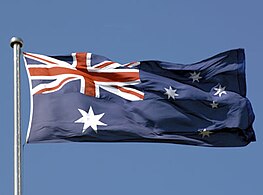Australian nationalism

Australian nationalism is the ideology, movement and sentiment that emphasizes the identity, culture, and interests of Australia as a nation-state, asserting the identity of Australians as a distinct nation, regardless of its previously derivative and colonial status.[1][2] It encompasses a range of beliefs and values that are often rooted in Australia's history, geography, and socio-political context.[3] Key elements of Australian nationalism include a sense of national pride, attachment to Australian symbols such as the flag and national anthem, and a focus on promoting Australia's sovereignty and independence.[4]
Historically, Australian nationalism emerged during the late 19th and early 20th centuries as Australia moved towards federation and gained independence from British colonial rule,[2][5] developing itself in three pivotal historical traditions: the labour movement, the republican movement and the native-nationalist movement.[6] It was shaped by factors such as the experiences of early settlers and the desire for a distinct Australian identity separate from British influence.[2][7]
History
Pre-Federation
By the early 19th century, Australia was governed as a series of six largely self-governing colonies that were spread across the continent and were part of the British Empire.[8] The name Australia was popularised by explorer Matthew Flinders and first used officially by Governor Macquarie.[9] Attempts to coordinate governance had failed in the 1860s due to a lack of popular support and lack of interest from the British government, but by the 1880s, and with the rise of nationalist movements in Europe, the efforts to establish a federation of the Australian colonies began to gather momentum. The British government supported federation as a means to cement British influence in the South Pacific.[10]
Figures like William Wentworth, John Dunmore Lang and Banjo Patterson championed Australian identity during the colonial era.
Post-Federation
Nationalistic sentiments increased as a result of Australia's participation in the First and Second World Wars, with concepts such as "mateship" becoming a cornerstone of Australian nationalism.[11]
See also
Flags
Flags used by Australian Nationalists
- Older variations of the Australian flag
- "The Men From Snowy River" flag used during World War I snowball marches
References
Footnotes
- ^ Knight 1995, p. 3: "Australian Nationalists assert that Australia is also a Nation regardless of our previously derivative and colonial status. The Australia Nation by its actions, creations, and expressions carries an Idea."
- ^ a b c "Nationalism in Australia". Archived from the original on 1 September 2016. Retrieved 11 March 2016.
- ^ "Surrendering nationalism". Griffith Review. Retrieved 11 March 2016.
- ^ Christopher Scanlon (25 January 2014). "Australia Day: is nationalism really so bad?". The Conversation. Retrieved 11 March 2016.
- ^ Hirst 2009.
- ^ Saleam 2000.
- ^ Pascale 2022.
- ^ Crisp 1949.
- ^ "Who Named Australia?". The Mail (Adelaide, South Australia). Adelaide: National Library of Australia. 11 February 1928. p. 16. Archived from the original on 17 April 2021. Retrieved 15 August 2024.
- ^ Trainor 1994, p. 3-4.
- ^ Trainor 1994, p. 4.
Sources
- Hirst, John (2009). Sense and Nonsense in Australian History. Black Incorporated. ISBN 9781921825408.
- Saleam, James (2000). Conservative Revolution, National Revolution And National Bolshevism Revisited: The Social Revolutionary Nature Of Australian Nationalism. Sydney: Australian Nationalist Ideological, Historical, and Legal Archive. Archived from the original on 20 November 2009.
- Pascale, Carmela (2022). History, Territory and Sovereignty: Celebrating Settler Nationalism in South Australia, 1900–1968 (PhD thesis). The University of Adelaide.
- Crisp, Leslie (1949). The Parliamentary Government of the Commonwealth of Australia. Adelaide: Longmans, Green & Co. Lotd. pp. 2.
- Trainor, Luke (1994). British Imperialism and Australian Nationalism: Manipulation, Conflict and Compromise in the Late Nineteenth Century. Cambridge University Press. ISBN 9780521436045.
- Knight, Brian (1995). Integral Nationalism: The Reborn Spirit of the Australian People. Melbourne: Radical Nationalism in Australia.





